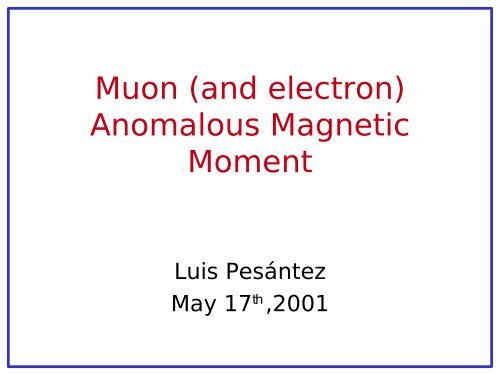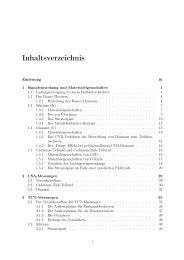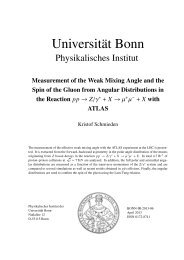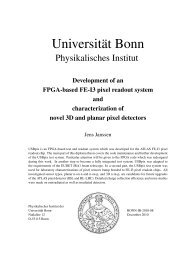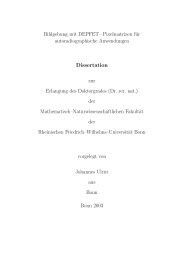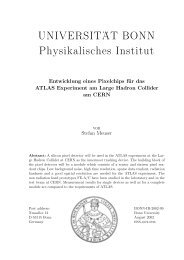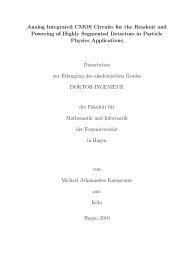Muon (and electron) Anomalous Magnetic Moment
Muon (and electron) Anomalous Magnetic Moment
Muon (and electron) Anomalous Magnetic Moment
Create successful ePaper yourself
Turn your PDF publications into a flip-book with our unique Google optimized e-Paper software.
<strong>Muon</strong> (<strong>and</strong> <strong>electron</strong>)<br />
<strong>Anomalous</strong> <strong>Magnetic</strong><br />
<strong>Moment</strong><br />
Luis Pesántez<br />
May 17 th ,2001
Why?<br />
• Explain discrepancies between<br />
theory <strong>and</strong> experiment.<br />
• Precision achieved is very high.<br />
• Very sensitive to new physics.<br />
2
• Introduction<br />
Outline<br />
– Measurement in <strong>electron</strong>s vs. muons<br />
• Radiative corrections<br />
– QED, HVP, EW<br />
• Experiments<br />
– Historical overview<br />
• E821 at Brookhaven<br />
– Achievements<br />
– Latest results<br />
• The future<br />
• Summary<br />
3
<strong>Magnetic</strong> moment<br />
• Intrinsic property of charged<br />
particles:<br />
• Pauli-Schroedinger equation predicts<br />
g s =2<br />
4
The anomaly<br />
• Early experiments show small<br />
disagreement:<br />
• Redefine g s as:<br />
Radiative corrections:<br />
5
Theory: corrections<br />
6
<strong>Muon</strong>s vs. <strong>electron</strong>s<br />
• Uncertainty in muon<br />
• But corrections go as<br />
7
<strong>Muon</strong>s vs. <strong>electron</strong>s<br />
8
Radiative corrections<br />
• Three types of contributions:<br />
– QED: photons <strong>and</strong> leptons (~100%)<br />
– HVP (~ 60 ppm)<br />
– EW: gauge bosons (~ 1.3 ppm)<br />
• Calculated both analytically <strong>and</strong><br />
numerically, also relies on<br />
experimental measurements.<br />
9
QED<br />
• C1 comes from Schwinger correction<br />
• Values computed up to 4 th order <strong>and</strong><br />
estimated 5 th order.<br />
10
• Two-loop<br />
QED: some Feynman<br />
• Three-loop<br />
(72 diagrams)<br />
diagrams<br />
11
Hadronic<br />
• Cannot be calculated from first<br />
principles.<br />
• All lowest order calculations related to:<br />
• Lattice QCD<br />
• Loops containing hadrons<br />
<strong>and</strong> leptons.<br />
12
Hadronic Vacuum Polarization<br />
13
Electroweak<br />
• Contribution is very small compared<br />
to QED <strong>and</strong> Hadronic.<br />
• Not sensitive to mass of Higgs<br />
(150 - 500 GeV).<br />
• Only one <strong>and</strong> two loop contribute,<br />
three loops in neglected O(10 -12 ).<br />
14
Electroweak<br />
15
Summary of theory<br />
16
Experimental history<br />
• 1947 anomaly observed in H<br />
hyperfine splitting (<strong>electron</strong>s).<br />
• 1948 Schwinger correction.<br />
• 1957 Nevis cyclotron: anomaly<br />
observed in muon, found to be<br />
~equal to anomaly in <strong>electron</strong>.<br />
17
CERN experiments<br />
• 1962: sensitive to order .<br />
• 1968: sensitive to order .<br />
• 1979: sensitive to order + had.<br />
18
E821 at Brookhaven<br />
19
E821 at Brookhaven<br />
• 1984: reach 0.35 ppm, test EW.<br />
• <strong>Muon</strong>s are stored in a ring (very<br />
uniform <strong>and</strong> stable Bfield).<br />
• Count number of <strong>electron</strong>s product<br />
of muon decay.<br />
20
Experimental idea<br />
21
<strong>Muon</strong> decay<br />
• <strong>Muon</strong>s produced from<br />
π decay are polarized<br />
(weak decay).<br />
• <strong>Muon</strong> spin precesses<br />
faster than<br />
momentum.<br />
22
Slow <strong>electron</strong><br />
Fast <strong>electron</strong><br />
<strong>Muon</strong> decay<br />
• Fast <strong>electron</strong>s are emitted with<br />
their momentum anti-parallel to<br />
muon spin.<br />
23
What is measured?<br />
• Spin precession frequency<br />
(interaction with Bfield):<br />
• Cyclotron frequency:<br />
• Anomaly:<br />
if<br />
24
Magic momentum<br />
• Electrostatic focusing changes the<br />
frequency:<br />
• Easy!<br />
25
Magic momentum<br />
• Electrostatic focusing changes the<br />
frequency:<br />
• Magic momentum:<br />
26
Detection<br />
• 24 electromagnetic calorimeters<br />
• Detect <strong>electron</strong>s above E th = 1.8 GeV.<br />
– Remember, we want fast <strong>electron</strong><br />
• We get more events depending on<br />
direction of muon spin.<br />
27
Determination of<br />
28
Calculating anomaly<br />
• B field determined with NMR (proton<br />
Larmor frequency)<br />
• And with λ measured from muonium<br />
hfs:<br />
• The anomaly is then:<br />
29
Dealing with errors<br />
• Different teams determining <strong>and</strong><br />
.<br />
• Blind data analysis.<br />
30
E821 results<br />
14 times more accurate than CERN<br />
experiment.<br />
Test of CPT in muons<br />
31
E821 results<br />
32
Current status<br />
33
Theoretical challenge<br />
• Find alternatives to explain<br />
discrepancy:<br />
– Leptons substructure<br />
– Supersymmetry<br />
34
Future experiments<br />
• E989 @ Fermilab<br />
– Reduce uncertainty to 0.16 ppm:<br />
5 - 6σ deviation.<br />
– Factor of 20 increase in statistics.<br />
– Significant reduction on systematic<br />
uncertainties.<br />
35
Future experiments<br />
36
What to remember<br />
• <strong>Muon</strong>s are “better” than <strong>electron</strong>s.<br />
• Precise test of SM.<br />
• All the physics is present in one<br />
number.<br />
• discrepancy, new physics?<br />
37
Light-by-light scattering<br />
39
Setup<br />
40
Electron anomaly<br />
41
Electron anomaly<br />
42
Electron anomaly<br />
43


